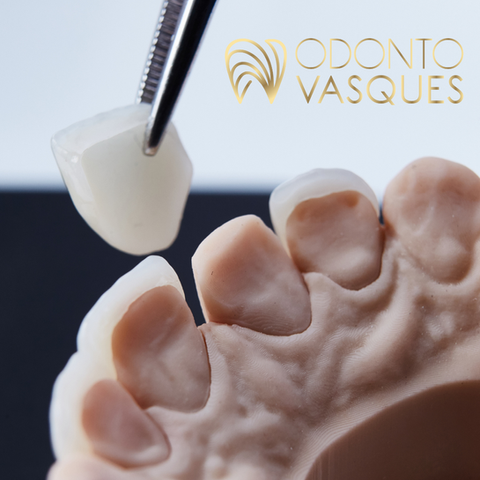
VENEERS
Resin and Porcelain Veneers
What is the difference between veneers and contact lenses?
Much is said about the difference in thickness between the two materials, but what differs from one another is the need to wear the tooth for application, which is done for two reasons: (i) so that the ceramic restoration is sufficiently thick to hide the tooth underneath and (ii) so that the material adapts well to the tooth. The choice of the technique that will be used — with or without wear of the tooth structure — and the material to be applied will depend on the teeth that will receive the covering. Well-positioned teeth, without stains and with previous restorations, can receive contact lenses. While for darker teeth, with large restorations and poorly aligned, the best indication is the veneer.
What materials are used?
Veneers can be made with composite resin or porcelain. Contact lenses, due to their delicate thickness, are always made of porcelain.
The resin used for veneers are ceramic restorations applied to the tooth. They resemble restorations made by dentists to restore cavities or fissures, but unlike these cases, resin veneers have an aesthetic purpose. Resin is a resistant material with a similar color to teeth, but it requires some care to maintain its ideal appearance. The resin, like the tooth, absorbs pigments from food, especially red wine and coffee. Therefore, veneers made with this material require a certain amount of care in their maintenance. Another important characteristic of the resin is that it can be applied by the dentist in the office, there is no need to send it to a laboratory for production. This makes the process much faster.
Porcelain is a material that resembles glass, used to cover tooth enamel to restore shape and color. It is an aesthetic material that reproduces the color, shine and reflection characteristics of enamel. Another quality that makes this material an excellent option for an aesthetic smile is its color resistance. Unlike composite resins, porcelain does not change color. Furthermore, porcelain, when glued and adhered to the tooth, becomes resistant, similar to the enamel itself. Despite its superior characteristics, porcelain requires more time to manufacture the veneers or lenses.
Can I improve the color of my teeth?
Yes. Patients who used antibiotics such as tetracycline during childhood have a brownish enamel color that is very difficult to remove. Furthermore, the consumption of certain foods and drinks — especially red wine, coffee, tea — and cigarettes can affect the color of your teeth, making them darker or yellower. Teeth whitening can help, but teeth with excessive discoloration are unlikely to reach an acceptable color with treatment. This happens because tooth color can change throughout life and yellowing is very common in older patients. Veneers, however, have the ability to cover stained and discolored enamel, returning the tooth to its original color.
Is it possible to change the shape of your teeth?
Yes. The natural wear and tear on your teeth can make them appear shorter and even rougher along the edges. To achieve this, veneers or dental contact lenses also incorporate these important features that have been lost, in addition to making the smile whiter and brighter. Regarding the shape, square, rectangular and round teeth are defined according to the patient's smile.
How much does it cost?
The cost of the treatment varies according to the material used and the number of teeth worked. Porcelain pieces are more expensive than resin pieces, as the material used and laboratory labor make the process more expensive. To obtain a quote, schedule an evaluation consultation with one of our specialists to create a personalized treatment plan according to your goals and financial conditions.




